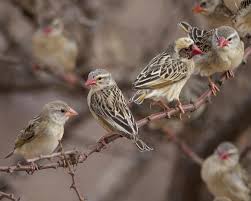The multi-billion naira satellite launched into the orbit by the federal government has no capacity to detect movement of thousands of red-billed quelea birds and locusts that travel thousands of miles to destroy crops in the country, Daily Trust has gathered.

National Space Research and Development Agency (NASRDA) said the Nigerian earth observation satellite is not meant to monitor birds and locusts.
NASRDA’s deputy director public communications, Dr Felix Ale told Daily Trust that the satellite could only feature bigger and larger objects of not less than 2.5meters, not smaller objects like quelea birds.
He said: “The satellite moves from one part of the earth to the other every day. It is not like your normal camera, it moves from one part and will be able to resolve details down to about 2.5m across. It observes the environment and in the process can pick mountains, rivers and vegetation. It is not meant to detect movement of locusts and birds; it can only tell us where they will likely get their foods. That is the vegetation and waters.”
The multibillion dollars satellite was produced by engineers at Surrey Satellite Technology Limited (SSTL) in Guildford, UK.
Nigeria’s first satellite launched on September 27, 2003 cost the nation $13 million USD. The satellite was expected boost communication, agriculture and security surveillance.
The country presently relies on information from neighbouring countries and cannot take proactive measures to curtail quelea birds and locusts invasion. The federal government recently learnt about an invasion when officials from affected states raised alarm at a meeting in Abuja.
Daily Trust correspondent in Jigawa state reports that quelea birds are already invading farms in seven local governments of the state destroying farm produce.

National Space Research and Development Agency (NASRDA) said the Nigerian earth observation satellite is not meant to monitor birds and locusts.
NASRDA’s deputy director public communications, Dr Felix Ale told Daily Trust that the satellite could only feature bigger and larger objects of not less than 2.5meters, not smaller objects like quelea birds.
He said: “The satellite moves from one part of the earth to the other every day. It is not like your normal camera, it moves from one part and will be able to resolve details down to about 2.5m across. It observes the environment and in the process can pick mountains, rivers and vegetation. It is not meant to detect movement of locusts and birds; it can only tell us where they will likely get their foods. That is the vegetation and waters.”
The multibillion dollars satellite was produced by engineers at Surrey Satellite Technology Limited (SSTL) in Guildford, UK.
Nigeria’s first satellite launched on September 27, 2003 cost the nation $13 million USD. The satellite was expected boost communication, agriculture and security surveillance.
The country presently relies on information from neighbouring countries and cannot take proactive measures to curtail quelea birds and locusts invasion. The federal government recently learnt about an invasion when officials from affected states raised alarm at a meeting in Abuja.
Daily Trust correspondent in Jigawa state reports that quelea birds are already invading farms in seven local governments of the state destroying farm produce.

